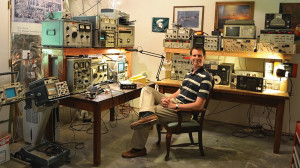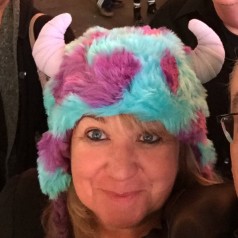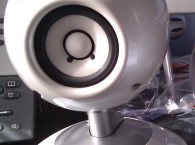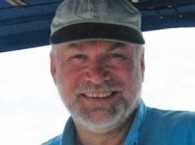
work station at his Westbrook, CT, home
to design, test, and build projects.
Gregory Charvat—an engineer, professor, entrepreneur, and author—encourages people to explore the opportunities that come their way.
SHANNON BECKER: Your interest in amateur radio equipment began when you were young and continued through your high school years. Can you describe some of your first projects?
GREGORY CHARVAT: I grew up in the metro Detroit, MI, area, and I was very interested in electronics for as long as I can remember, almost naturally. As a young child, I wanted to understand where all the people and things on television came from. One day we took apart an old television set so I could see how it worked.
My mother studied electrical engineering at Lawrence Technological University, which is an engineering school outside Detroit. She occasionally brought me to her classes and labs. Later while she was working at Ford Electronics, she sometimes would take me to work on the weekends, which was super exciting because I was able to make circuit boards, use oscilloscopes, and so forth (this was maybe from age 10–13).
I learned how to use transistors at age 10. I became interested in CB radios. At about the same time, I helped my friends dust off CB radios from their parents’ attics and we built a very nice CB radio network. When I was about 13, I transitioned into amateur radio because my mother wanted me to try a more sophisticated hobby—one where you build your own equipment and communicate across great distances.
My first electronics projects that I can remember involved building a large switch panel that ran off an old model train transformer to power a car radio, a fan, a light bulb, and other things. Next, I outfitted my bike with buzzers, lights, and a generator to power them with a rechargeable battery. Shortly thereafter, amateur radio became my main interest. I built a 2-m transceiver kit, a 2-m power amplifier kit, modified old police radio power amplifiers to work on 2 m, and many other things. In high school I became involved in a radio telescope project. My role was to upgrade the receiver to a more advanced scanning spectrum analyzer with analog signal-tracking circuits that I developed. Some of these circuits were later used in a friend’s dissertation at Michigan State University.
When I was 16, I interned at Aeroflex Lintek, a defense contractor, helping build radars used to measure the radar cross section of stealth aircraft. From there I became interested in radar technology and I was amazed that you could make images with microwaves. I recall repairing the rotator at Mission Research in Dayton, OH, testing low-noise amplifiers (LNAs) on an HP8510 network analyzer, building many boards, military-specification cables, chassis, mounting power supplies, and finding parts in catalogs for designs.
SHANNON: What is your current occupation? Are you still involved with Butterfly Network?
GREGORY: I am the co-founder of Butterfly Network, which is a privately held company that brings together world-class talent in computer science, physics, and electrical engineering to create an entirely new approach to diagnostic imaging and treatment. I lead the hardware team, which is our company’s largest group. We are responsible for the development of the hardware for the company’s first product.
SHANNON: Can you describe some projects you’ve done?
GREGORY: I built the first three prototypes, set up our lab and machine shop, recruited more than half the company, negotiated a number of contracts, and now I am learning about application-specific integrated circuit (ASIC) engineering. We are looking for an analog ASIC engineer and a chip packaging engineer, for anyone who is interested in working with me. I can be reached at charvatg@gmail.com. I will reply to all e-mails.
SHANNON: Are you still instructing at the Massachusetts Institute of Technology (MIT)? Can you describe the courses you teach?
GREGORY: My Build a Small Sensor Radar course continues to this day. In June, it was offered as an MIT Professional Education course. Numerous universities have adopted this course as either a capstone engineering project or full-semester course. Private institutions and government labs have also adopted the course for internal training. The coffee-can radar project has even made an appearance on Mongolian National Television as part of an MIT EdX program a friend of mine ran last summer. You can now buy the coffee-can radar project as a complete kit from Quonset Microwave.
Additionally, two other Build a Radar courses were developed from the original course including Build a Phased-Array Radar and Build a Search and Track Radar, but I am no longer teaching these courses. My relationship with MIT has evolved into me being an advisor for the Camera Culture Group at the MIT Media Lab where we experiment with two interesting technology threads.
SHANNON: You have a main website, a blog, Mr. Vacuum Tube; several YouTube videos; and an active Twitter account. What types of projects do you typically share?
GREGORY: I like to read other people’s Twitter posts and blogs and I watch YouTube videos. I appreciate the time and effort other enthusiasts put into sharing their work. To this end, I like to share what I am doing and maybe it can help someone someday. For this reason I try to share everything I can, from symposiums that I am involved in to topics in my book, to papers I am publishing to hobbyist projects (e.g., vacuum-tube audio, antique radio restorations, clock and watch restorations, and sailing adventures).
As an undergraduate, I learned from a math professor friend of mine that you must publish everything you create, otherwise the knowledge will be lost.
SHANNON: You are a Senior Member of the Institute of Electrical and Electronics Engineers (IEEE). What does your involvement entail?
GREGORY: I’m a huge fan of the IEEE. The IEEE organization maintains high academic standards for papers in its journals and symposiums and I really appreciate that. IEEE members are the archivists and storytellers of electrical engineering history, past and present. To help out, I was chairman of the IEEE Antennas and Propagation Society Boston Section for two years. Our meetings went from 12 attendees each month to 40 by my tenure’s end. This was achieved by the use of social media and the lineup of fascinating speakers. I then became a Member-at-Large for the IEEE Boston Section’s Executive Committee in 2012. Additionally, I was on the steering committee for the 2010 International Symposium on Phased-Array Systems & Technology. I am currently on the steering committee for the 2013 symposium this fall in Waltham, MA.
SHANNON: You have authored many articles, including a two-part audioXpress series, “Vacuum Tube Home Theater System” (May–June, 2012), about building a “monster” system with 23 vacuum tubes. Tell us a little about the system. Have you made any upgrades or adjustments?
GREGORY: This system was originally developed in the summer of 2001 while I was a junior undergraduate. It was deployed in my dorm room. The feedback compensation networks were upgraded in 2003. The power supply was upgraded in 2005 and I moved to a direct grid-bias configuration to get more power out of the amplifiers.
In 2009, I again upgraded the feedback compensation networks. This system is in our living room and it is used almost every day. It is currently in a maintenance posture, where I occasionally have to replace one of the original tubes from 2001. Recently I had to replace a high-voltage rectifier diode. I’m due to replace the pentodes on the subwoofer amplifier within the next few weeks.
SHANNON: Your forthcoming book, Small and Short Range Radar Systems, is slated for publication in February 2014. What can readers expect to learn?
GREGORY: This will be the first book on small and short-range radar devices. My goal for the book is to show readers how they work, how to build something practical, and do it quickly.
I want to show readers the high-level basics and how to do a back-of-envelope estimate to determine if a system is worth developing. I also wanted to provide working engineering examples of each type of short-range radar, including complete schematics, diagrams, bill of materials (BOM), a demonstration video, data for the reader to process from that video, and usable MATLAB scripts. I also discuss the practical aspects of design so these examples can be scaled to other applications or expanded.
As engineers, we are applied scientists. We use our understanding of physics to build something tangible to help humanity. This book facilitates that process for short-range radar sensors.

20-m single-sideband (SSB) of his own design.tion
SHANNON: Tell us about the amateur radio station you designed.
GREGORY: After hearing stories about a friend of mine at the MIT Haystack Observatory, who as a teenager built his own radio out of one type of transistor his father was able to “borrow” from work, I decided to redo this exercise myself. I developed a shortwave receiver out of one type of transistor. It was a fascinating experience.
From there, I decided to develop my own single-sideband (SSB) transceiver design from scratch. I built a 20-m SSB radio with 40-W peak-envelope power (PEP) that is extremely sensitive. It was an amazing experience to contact Western Europe with a radio that I developed myself!
Shortly thereafter, the American Radio Relay League (ARRL) issued the Homebrew Challenge III, to build a 10-m and 6-m SSB/CW transceiver for less than $200. I took this challenge and submitted a working radio one day before the contest ended. Apparently mine was one of only two submissions. The other was late, but I blew the budget at $450! (It’s really about the experience, not the cost.) I was given honorable mention and an article in QST magazine for my efforts. More importantly, I had the pleasure of getting to know some of the folks at ARRL.
Most recently, I developed a way of tying a SSB transmitter to an R-390A, which is the tube era’s best communications receiver and highly sought after by collectors. An article on this modification will run soon in QST’s “Hints and Kinks” column.
In summary, my homemade amateur radio station consists of a 20-m SSB radio, a 10-m and 6-m SSB/CW radio, and an R-390A that is tied into the 20-m radio for when I want to run in “boat anchor” mode.

SHANNON: If you had a full year and an ample budget to work on any design project you wanted, what would you build?
GREGORY: If I had a free weekend in the summer I’d sail to Long Island, NY. If I had a free weekend in the fall, winter, or early spring I’d restore a vintage mechanical wristwatch. If I had a free week I would restore the vintage all-tube Telefunken stereo receiver in my office. Or, I’d combine a 1970s solid-state amateur radio transmitter with my R-390A. If I had one to four months, I would bring to close the projects I am helping with at MIT’s Media Lab.
After that, I would look for something long term. I would probably brainstorm with some friends about a new idea for a fun research project or a startup. Generally speaking, I would like to have one long-term project moving steadily along while also closing numerous shorter-term projects along the way.





